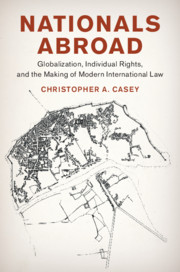Book contents
- Frontmatter
- Dedication
- Contents
- Acknowledgments
- Abbreviations
- Introduction
- Part I Mise-en-scène: The International Legal World, 1850–1914
- 1 The Walls of Gilgamesh
- 2 Making Nations, Breaking Nationality
- Part II Mise-en-scène: The International Legal World, 1919–1939
- Part III Mise-en-scène: The International Legal World, 1945–Present
- Notes
- Index
1 - The Walls of Gilgamesh
from Part I - Mise-en-scène: The International Legal World, 1850–1914
Published online by Cambridge University Press: 29 June 2020
- Frontmatter
- Dedication
- Contents
- Acknowledgments
- Abbreviations
- Introduction
- Part I Mise-en-scène: The International Legal World, 1850–1914
- 1 The Walls of Gilgamesh
- 2 Making Nations, Breaking Nationality
- Part II Mise-en-scène: The International Legal World, 1919–1939
- Part III Mise-en-scène: The International Legal World, 1945–Present
- Notes
- Index
Summary
By the eighteenth century, it was a fundamental precept of the law of nations that “whoever uses a citizen ill, indirectly offends the state, which is bound to protect this citizen; and the sovereign of the latter should avenge his wrongs, punish the aggressor, and, if possible, oblige him to make full reparation; since otherwise the citizen would not obtain the great end of the civil association, which is safety.” Put another way, states were forbidden from arbitrarily harming the subjects of another state. Over the nineteenth century, states developed a robust set of political and legal procedures to manage the conflicts that increasingly emerged as millions of people began to migrate across the Atlantic. But, just who was entitled to protection became a source of irreconcilable tension within the system. Were Italian immigrants who had lived in Argentina for decades entitled to Italian protection? What about Irish immigrants in America? Such questions befuddled policymakers and jurists.
Keywords
- Type
- Chapter
- Information
- Nationals AbroadGlobalization, Individual Rights, and the Making of Modern International Law, pp. 17 - 45Publisher: Cambridge University PressPrint publication year: 2020

